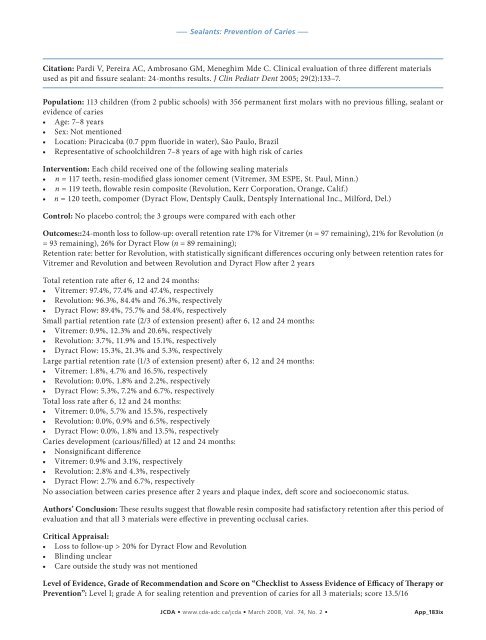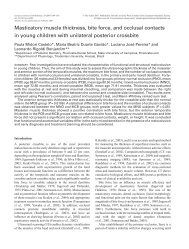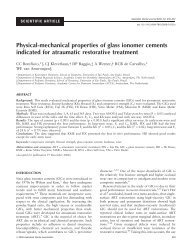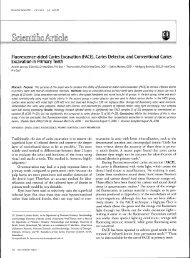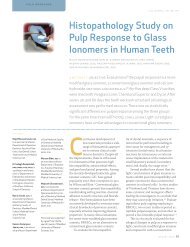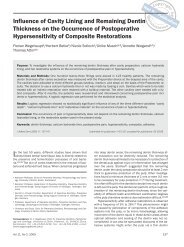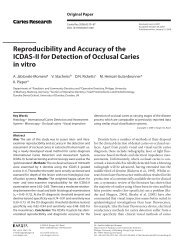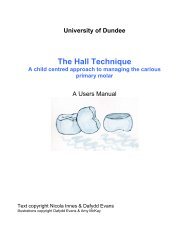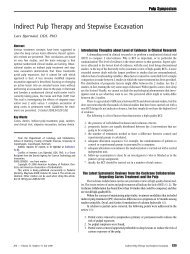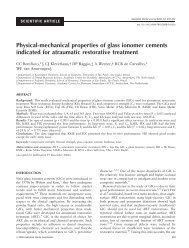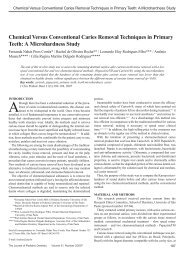Pit and Fissure Sealants in the Prevention of Dental Caries in ...
Pit and Fissure Sealants in the Prevention of Dental Caries in ...
Pit and Fissure Sealants in the Prevention of Dental Caries in ...
Create successful ePaper yourself
Turn your PDF publications into a flip-book with our unique Google optimized e-Paper software.
––– <strong>Sealants</strong>: <strong>Prevention</strong> <strong>of</strong> <strong>Caries</strong> –––<br />
Citation: Pardi V, Pereira AC, Ambrosano GM, Meneghim Mde C. Cl<strong>in</strong>ical evaluation <strong>of</strong> three different materials<br />
used as pit <strong>and</strong> fissure sealant: 24-months results. J Cl<strong>in</strong> Pediatr Dent 2005; 29(2):133–7.<br />
Population: 113 children (from 2 public schools) with 356 permanent first molars with no previous fill<strong>in</strong>g, sealant or<br />
evidence <strong>of</strong> caries<br />
• Age: 7–8 years<br />
• Sex: Not mentioned<br />
• Location: Piracicaba (0.7 ppm fluoride <strong>in</strong> water), São Paulo, Brazil<br />
• Representative <strong>of</strong> schoolchildren 7–8 years <strong>of</strong> age with high risk <strong>of</strong> caries<br />
Intervention: Each child received one <strong>of</strong> <strong>the</strong> follow<strong>in</strong>g seal<strong>in</strong>g materials<br />
• n = 117 teeth, res<strong>in</strong>-modified glass ionomer cement (Vitremer, 3M ESPE, St. Paul, M<strong>in</strong>n.)<br />
• n = 119 teeth, flowable res<strong>in</strong> composite (Revolution, Kerr Corporation, Orange, Calif.)<br />
• n = 120 teeth, compomer (Dyract Flow, Dentsply Caulk, Dentsply International Inc., Milford, Del.)<br />
Control: No placebo control; <strong>the</strong> 3 groups were compared with each o<strong>the</strong>r<br />
Outcomes::24-month loss to follow-up: overall retention rate 17% for Vitremer (n = 97 rema<strong>in</strong><strong>in</strong>g), 21% for Revolution (n<br />
= 93 rema<strong>in</strong><strong>in</strong>g), 26% for Dyract Flow (n = 89 rema<strong>in</strong><strong>in</strong>g);<br />
Retention rate: better for Revolution, with statistically significant differences occur<strong>in</strong>g only between retention rates for<br />
Vitremer <strong>and</strong> Revolution <strong>and</strong> between Revolution <strong>and</strong> Dyract Flow after 2 years<br />
Total retention rate after 6, 12 <strong>and</strong> 24 months:<br />
• Vitremer: 97.4%, 77.4% <strong>and</strong> 47.4%, respectively<br />
• Revolution: 96.3%, 84.4% <strong>and</strong> 76.3%, respectively<br />
• Dyract Flow: 89.4%, 75.7% <strong>and</strong> 58.4%, respectively<br />
Small partial retention rate (2/3 <strong>of</strong> extension present) after 6, 12 <strong>and</strong> 24 months:<br />
• Vitremer: 0.9%, 12.3% <strong>and</strong> 20.6%, respectively<br />
• Revolution: 3.7%, 11.9% <strong>and</strong> 15.1%, respectively<br />
• Dyract Flow: 15.3%, 21.3% <strong>and</strong> 5.3%, respectively<br />
Large partial retention rate (1/3 <strong>of</strong> extension present) after 6, 12 <strong>and</strong> 24 months:<br />
• Vitremer: 1.8%, 4.7% <strong>and</strong> 16.5%, respectively<br />
• Revolution: 0.0%, 1.8% <strong>and</strong> 2.2%, respectively<br />
• Dyract Flow: 5.3%, 7.2% <strong>and</strong> 6.7%, respectively<br />
Total loss rate after 6, 12 <strong>and</strong> 24 months:<br />
• Vitremer: 0.0%, 5.7% <strong>and</strong> 15.5%, respectively<br />
• Revolution: 0.0%, 0.9% <strong>and</strong> 6.5%, respectively<br />
• Dyract Flow: 0.0%, 1.8% <strong>and</strong> 13.5%, respectively<br />
<strong>Caries</strong> development (carious/filled) at 12 <strong>and</strong> 24 months:<br />
• Nonsignificant difference<br />
• Vitremer: 0.9% <strong>and</strong> 3.1%, respectively<br />
• Revolution: 2.8% <strong>and</strong> 4.3%, respectively<br />
• Dyract Flow: 2.7% <strong>and</strong> 6.7%, respectively<br />
No association between caries presence after 2 years <strong>and</strong> plaque <strong>in</strong>dex, deft score <strong>and</strong> socioeconomic status.<br />
Authors’ Conclusion: These results suggest that flowable res<strong>in</strong> composite had satisfactory retention after this period <strong>of</strong><br />
evaluation <strong>and</strong> that all 3 materials were effective <strong>in</strong> prevent<strong>in</strong>g occlusal caries.<br />
Critical Appraisal:<br />
• Loss to follow-up > 20% for Dyract Flow <strong>and</strong> Revolution<br />
• Bl<strong>in</strong>d<strong>in</strong>g unclear<br />
• Care outside <strong>the</strong> study was not mentioned<br />
Level <strong>of</strong> Evidence, Grade <strong>of</strong> Recommendation <strong>and</strong> Score on “Checklist to Assess Evidence <strong>of</strong> Efficacy <strong>of</strong> Therapy or<br />
<strong>Prevention</strong>”: Level I; grade A for seal<strong>in</strong>g retention <strong>and</strong> prevention <strong>of</strong> caries for all 3 materials; score 13.5/16<br />
JCDA • www.cda-adc.ca/jcda • March 2008, Vol. 74, No. 2 • App_183ix


